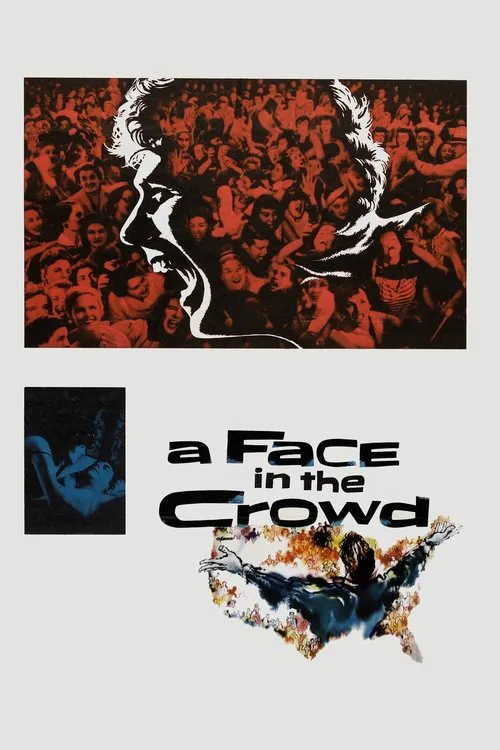A Face in the Crowd

Plot
In the 1957 cinematic masterpiece, A Face in the Crowd, the film takes viewers on an unsettling journey through the meteoric rise of a boisterous, charismatic, and manipulative radio and television personality in America's turbulent post-war era. The film, directed by Elia Kazan and written by Budd Schulberg, presents a piercing satire that scrutinizes the darker aspects of American culture and the corrupting influence of media on the masses. The narrative centers around Lonesome Rhodes (played by Andy Griffith), a rough-around-the-edges, guitar-picking Ozark native who finds himself in jail on a charge of inciting a riot. It is in this dingy, forgotten corner of American society that we first meet Marcia Jeffries (played by Patricia Neal), a beautiful, intelligent, and naive young woman attending Sarah Lawrence College. Marcia, a social worker with a strong sense of justice, discovers Lonesome in the depths of the jail and is immediately captivated by his raw energy, unbridled passion, and irrepressible charm. Marcia, recognizing the raw talent and potential latent in Lonesome, decides to champion his cause, and together they concoct a plan to transform the uneducated, uncouth, but charismatic hayseed into a media sensation. With Marcia's guidance, Lonesome's natural charisma and folksy persona begin to gain traction on the local radio circuit. His down-to-earth, homespun style, coupled with his uncanny ability to tap into the frustrations and aspirations of the common man, quickly establishes Lonesome as a beloved figure among rural America. As Lonesome's popularity grows, Marcia finds herself increasingly enthralled by his larger-than-life persona and begins to sacrifice her own values and principles for the sake of his meteoric rise to fame. Meanwhile, Lonesome begins to shed his authentic self, replacing it with a contrived, commercialized image tailored to appease his television and radio audiences. As Lonesome's influence expands across the country, he is soon courted by powerful politicians, media moguls, and business leaders eager to harness his vast popularity and manipulate public opinion for their own interests. Lonesome, aware of his newfound leverage, begins to leverage his influence to peddle his own brand of populist demagoguery, capitalizing on the fears and anxieties of the American public to advance his own agenda. Throughout the film, Lonesome's character is juxtaposed against a backdrop of growing social unrest, economic uncertainty, and Cold War paranoia. As America grapples with these complex and daunting issues, Lonesome's simplistic, bombastic solutions begin to resonate with a disaffected public hungry for reassurance and easy answers. One of the most striking aspects of A Face in the Crowd is its prescient portrayal of the destructive potential of populism and the manipulative power of the media. In a society increasingly reliant on mass communication and celebrity culture, the film's critique of the ways in which the media can distort and control public opinion remains eerily relevant today. As the narrative hurtles toward its climactic conclusion, Marcia begins to confront the consequences of her Faustian bargain with Lonesome. She is forced to choose between her loyalty to the man she once championed and her own sense of morality and integrity. The film's final scenes are a powerful exploration of the human costs of Lonesome's meteoric rise to fame, as Marcia is left to grapple with the wreckage of her own compromised values and the devastating consequences of her blind worship of a charismatic but ultimately flawed and manipulative figure. In A Face in the Crowd, Elia Kazan and Budd Schulberg present a scathing critique of the darker aspects of American culture and the corrupting influence of media on the masses. This powerful and unsettling film is a masterclass in narrative storytelling, character development, and social commentary, offering a piercing insight into the complexities and contradictions of American society in the post-war era.
Reviews
Recommendations




